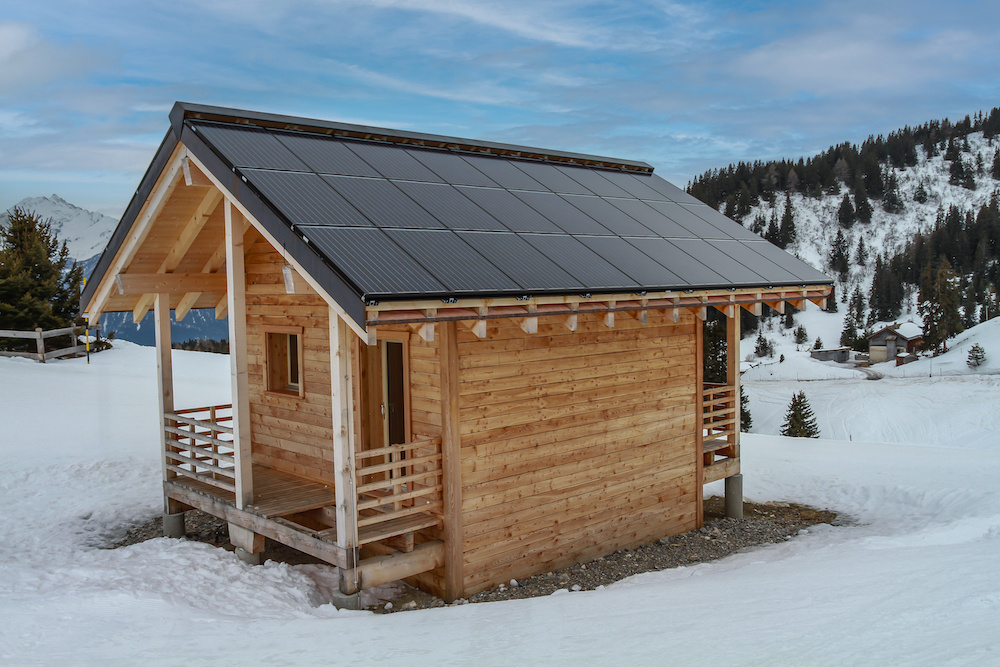Solar Power for Tiny Houses 2025 | How Much Do You Need?

Living in a tiny house is more than just a space-saving trend; it’s a philosophy of intentional living and environmental consciousness. And in 2025, harnessing the power of the sun through solar panels for tiny house has become easier and more appealing than ever.
solar power for tiny houses
How Much Solar Power Do I Need for My Tiny House in 2025?
As we into 2025, the tiny house movement continues to grow rapidly, driven by the desire for minimalist living, environmental sustainability, and energy independence.
If you’re planning to live in a tiny house or already own one, you’re likely wondering:
How much solar power do I need for my tiny house in 2025?
The exact number you need will depend on the size of your home, your electricity usage, and the angle shading and orientation of your roof. On average, you might need between 15 and 20 solar panels to fully power a typical home in the US.
Solar Power In Your Tiny House! How?
Tiny houses are all about maximizing efficiency in a minimal space,
The tiny home market is poised to reach an impressive $6.9 billion by 2029, and more and more people are seeking out sustainable, flexible, and cost-effective living solutions.
Understanding Your Tiny House Energy Needs
Before sizing your solar system, it’s critical to understand how much electricity your tiny house consumes daily.
Common Appliances in Tiny Homes
Most tiny homes use energy-efficient appliances. Here’s an average daily breakdown (estimates based on energy-efficient usage):
| Appliance | Power Usage (W) | Daily Use (Hours) | Daily Consumption (Wh) |
|---|---|---|---|
| Mini fridge | 100 | 24 | 2,400 |
| LED lighting (5 bulbs) | 10 each | 5 | 250 |
| Laptop | 60 | 4 | 240 |
| Phone charger | 5 | 3 | 15 |
| Electric kettle | 1,200 | 0.2 | 240 |
| Water pump | 250 | 1 | 250 |
| Heater or AC (seasonal) | 1,000 | 3 | 3,000 |
Total Daily Energy Usage: Around 6,395 Wh/day (or 6.4 kWh/day)
How to Calculate Your Solar Needs
Step 1 – Know Your Location’s Sunlight Hours
Solar energy production depends on peak sun hours. For example:
| City (U.S.) | Avg Sun Hours/Day |
|---|---|
| Phoenix, AZ | 6.5 |
| San Diego, CA | 5.5 |
| Denver, CO | 5.0 |
| Portland, OR | 4.0 |
| New York, NY | 4.2 |
If your tiny house is mobile, choose sunny regions to maximize efficiency.
Step 2 – Solar Panel Output
Let’s say you live in San Diego (5.5 peak sun hours).
To generate 6.4 kWh/day:
- Required panel output = 6,400 Wh ÷ 5.5 = 1,164 Watts (or ~1.2 kW)
However, due to energy loss (15–25%), you should oversize:
1.5 kW – 2.0 kW system is ideal.
How Many Solar Panels Will You Need?
The number of panels depends on panel wattage.
| Panel Size | Wattage | Panels Needed (1.8 kW system) |
|---|---|---|
| Compact panels | 100W | 18 panels |
| Standard panels | 250W | 7–8 panels |
| High-efficiency | 400W | 5 panels |
Advantages of tiny homes with solar in 2025:
Solar panels will slash your electric bills
A small solar system between 1 kilowatt (kW) and 3 kilowatts in size – enough to cover the needs of pretty much any tiny home – will result in average savings of between $250 and $750 annually.
Solar panels offer a great return
The best part is that with a tiny house, this can be achieved with a relatively small investment. A 3kW system, for instance, will cost you just $5,985 (based on a cost/watt of $2.85, and net of the 30% solar tax credit).
Solar power offers clean, renewable energy
Solar panels provide clean energy: they are completely emissions-free, meaning that they can substantially reduce your overall carbon footprint. The power they produce is also renewable – the sun shines anew every day, and no resources are consumed when we harness its rays.
Solar systems can be customized to your needs
They can be designed to be as large or as small as you need.
This is a major advantage as it addresses what’s probably the biggest challenge for tiny homeowners.
Disadvantages of solar for tiny houses
Solar panels offer a sustainable energy solution for tiny houses; they also present some disadvantages.
These include the high initial cost, reliance on sunlight, potential for weather limitations, and the need for energy storage, which can be expensive and bulky
A small 1 kW solar system will cost around $3,250, while a larger 3 kW system will cost around $9,750 – these prices are before any incentives and rebates.
Reliance on Sunlight:
- Solar panels only generate electricity when exposed to sunlight, meaning they are dependent on weather conditions and daylight hours.
- This can be problematic during cloudy or rainy days, and at night, requiring battery storage to ensure a consistent power supply.
Space Constraints:
Tiny houses often have limited roof space, which may restrict the number and size of solar panels that can be installed.
Maintenance:
Solar panels and battery systems require occasional maintenance and may incur repair costs.
Why Go Solar in Your Tiny Home? The major reason
Tiny houses, by their very nature, encourage mindful energy consumption. Pairing this inherent efficiency with solar technology takes it a step further, enabling you to achieve remarkable energy independence and environmental impact reduction. Imagine powering your cozy haven with sunshine!

Go Solar!
Tech Breakthroughs Light the Way
The world of solar is constantly evolving, and 2025 brings exciting advancements. High-efficiency solar panels capture more sunlight per unit area, requiring fewer panels on your tiny roof.
Think sleeker aesthetics and maximized space! Plus, innovative flexible solar panels can conform to curved surfaces, making them ideal for unconventional, tiny house shapes.
Limited space doesn’t have to limit your solar dreams
Compact solar panels designed for rooftops and even ground mounting, along with modular battery storage solutions, make the most of every inch. You can customize your system to perfectly match your energy needs and available space.
Living Off the Grid, Big on Freedom
Imagine waking up to the sun, knowing it’s powering your morning coffee. With solar, you ditch the grid and embrace off-grid living. Tiny houses are prime candidates for solar independence, thanks to their naturally low energy consumption. Sure, there are challenges, like cloudy days, but smart energy management and efficient appliances can bridge the gap.
Making Green Cents with Sunshine
The cost of solar panels has steadily dropped in recent years, making them more accessible than ever. Combine that with government incentives and rebates in many regions, and you’ve got a recipe for significant cost savings. The upfront investment pays off in the long run through dramatically reduced energy bills and increased property value.
Designing with Sunshine in Mind
Planning your tiny house build? Integrate solar from the get-go! Consider roof orientation for optimal sun exposure, choose skylights that strategically channel sunlight, and incorporate sleek panel mounts that blend seamlessly with your home’s aesthetics. Remember, solar can be beautiful!
Shining a Light on the Planet
By choosing solar, you’re not just powering your tiny house; you’re making a global impact. Reduced carbon footprint, cleaner air, and a smaller reliance on fossil fuels are just a few ways you contribute to a brighter future. Every watt of sunshine harnessed makes a difference.
Keeping Your Sunshine System Glowing
Like any investment, your solar panels need TLC. Regular cleaning, checking for any loose connections, and monitoring battery health will ensure optimal performance. Most systems are relatively low-maintenance, but proactive care keeps your sunshine flowing!
Before diving into solar, familiarize yourself with local building codes and regulations. These can vary by region, so ensure your system complies with safety standards and permitting requirements. Remember, knowledge is power, especially when it comes to harnessing the sun’s power!
Sharing the Sunshine, Sharing the Joys
Tiny house communities often thrive on collaboration. Consider cooperative solar installations where multiple homes share a larger system, reducing individual costs and maximizing efficiency. Working together shines a brighter light on sustainable living!
Tiny House, Big Solar Stories
Ready to be inspired? Hear from fellow tiny house dwellers who have embraced solar. Their real-life experiences, challenges overcome, and the joys of sunshine-powered living will provide valuable insights and fuel your solar journey.
A Sun-Kissed Future for Tiny Homes

sun kissed tiny house
The future of tiny house solar is dazzling! Expect technological advancements like even more efficient panels, integrated smart monitoring systems, and seamless grid integration options. As the tiny house movement gains momentum, so will the adoption of solar solutions, paving the way for a brighter, more sustainable future.
Conclusion
Living in a tiny house is about making conscious choices. Choosing solar panels for tiny houses in 2025 is a powerful statement about your commitment to sustainable living, energy independence, and environmental responsibility. It’s about harnessing the power of the sun to illuminate not just your tiny haven, but also the path towards a brighter future for our planet. So, step into the sunshine, tiny house dweller, and let your light shine!
Explore Related: Will My House Sell More with Solar Panels Compass (2024 Guide)
Solar Essence in Stardew Valley: A Guide to Maximizing Its Benefits
FAQs About Solar Panels For Tiny Houses
Depends on energy needs & location. Consult a solar installer for a personalized estimate.
Yes, with efficient panels & battery storage. Consider energy management strategies for cloudy days.
Costs have dropped! Rebates & low energy bills make it a worthwhile investment.
Regular cleaning & checking connections. Most systems are low-maintenance, but proactive care optimizes performance.
This comprehensive guide aims to provide up-to-date insights into utilizing solar panels for tiny houses in 2025, covering technological advancements, practical solutions, and real-life experiences to empower individuals in the tiny house movement towards sustainable and energy-efficient living.
